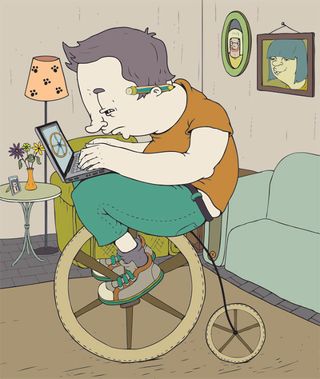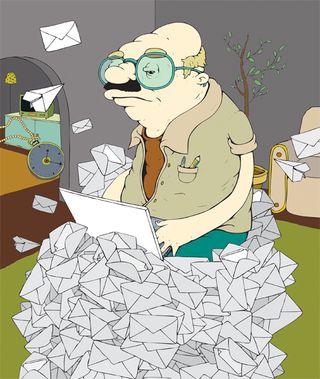4 logo design nightmares and how to deal with them
Four anonymous logo designers share their cautionary tales of woe, and we provide some helpful advice.
A new logo or branding commission always seems like an exciting prospect. Until the seventeenth round of amends, that is. Some clients simply can't decide what they want, or can't resist demanding changes purely for the sake of it. To find out more, we spoke to four creatives (who've stayed anonymous to protect those involved) who recall nightmare branding projects, detailing exactly what went wrong.
You may not be able to prevent these awkward situations, but you can prepare yourself with certain techniques for dealing with them.
01. Endless client nitpicking

"I was designing a logo for a client, combining a wheel with the name of the company. I had asked for a brief and showed them three initial design concepts. They clearly identified the one they liked and we began moving in that direction. The client was very specific, so I was really pleased because, of course, the more specific the brief and feedback, the easier it is to make sure you stay on the right track. I was thrilled, because they seemed like the perfect client.
"We had agreed to have three additional rounds of design. The first two rounds went extremely smoothly: the client just wanted to tweak the colours a bit, and they loved the font. They asked for the icon to be made a little bit larger - then we'd be there. It seemed like the project was almost complete.
"At this point, however, they then decided that they didn't like the look of the wheel I had been using. First, they asked for it to have six spokes instead of five. I was happy to do this because it was what the client wanted - it was no big deal. But then they seemed to go from loving the whole thing to getting more and more nitpicky, following up this request with a whole lot more. For example, they decided that the spokes needed to be wider at the top than at the bottom, and they also complained that the tyre didn't look as if it had been blown-up enough.
The client was arguing that these didn't count as rounds of design
"Meanwhile, as all this was going on, the client was arguing that these didn't count as rounds of design because the basic concept was already in place, and we were just making minor adjustments. In their view, they hadn't exceeded the pre-agreed limit.
"I told the client I would do the work they wanted, but that I would charge on an hourly basis because it was outside the scope of the project. We were only able to finish it because, when it got to round eight or nine, I told them that enough was enough: they could have one last round of changes, and it was fine if they wanted someone else to work on the project after that. I'm really not sure if it would ever have been signed off by them otherwise."
Get the Creative Bloq Newsletter
Daily design news, reviews, how-tos and more, as picked by the editors.
Anonymous designer, New York
What to do: our advice
There's a limit to how much you can communicate in the beginning: while you need to be clear, you don't want to scare off the client by over-articulating yourself. Be realistic: some projects will be more straightforward than others, but know when it's time to say stop.
02. "I don't like the colour"

"I was working with a big client to design a microsite and logo. They were very receptive in the early stages, only to later go through a routine that a large number of creatives will probably find all too familiar. They seemed to be trying to flex their muscles, but they did this by asking for something completely ridiculous.
"The concept for the logo and the overall look and feel of the site had initially been signed off in blue. The colour scheme had never been up for discussion - it was always going to be blue. The website had an evening and night-time theme, so we needed to ensure it evoked the right kind of mood, and the blue we used worked well with the client's overall visual identity.
"This was a six-week project. About four weeks in, things were ticking along nicely and the client seemed very happy. Then I had a conference call with him one morning and, completely out of nowhere, he suddenly said: 'I've been thinking. How about we do the design in pink instead?'
I've been thinking. How about we do the design in pink instead?
"I hadn't expected that. I was fairly junior at the time and unsure about how to handle the situation, so I asked my senior designer for advice. He said it was a case of proving the client wrong by doing what he thought he wanted, as then he would be able to see for himself that it simply wouldn't work. So I redid the design in pink and called the client.
"'Now, about the pink,' he said. 'I'm just not sure it's quite the right pink. Is it possible to redo it in maybe... 12 different shades?'
"Twelve shades of pink later, I was in a conference call wondering if my five years of studying design really had come down to this moment. 'I've been thinking,' the client said ominously. 'Thanks very much for sending over those pinks. There are some really good colours in there. The thing is, though, I kind of just want to go with the blue now, actually.'
"The main lesson here is that, sometimes, clients will ask for something that won't work - and the way to change their minds is to show them, not tell them."
Anonymous digital designer, London
What to do: our advice
It's important to keep clients happy while encouraging them to trust your expertise. Sometimes they'll ask for things that just won't work. It's best to start doing what they've asked, so they don't think you're ignoring them - but then provide a better version. That way, they'll see for themselves.
03. 400 emails and a migraine

"I made a crucial mistake that a lot of freelancers make: working for a friend. I thought he was nice, but I hadn't been exposed to his business demeanour. The project was branding and logo creation for his sales and marketing company.
"In the beginning, he wanted something similar to another company's emblem. I told him that this wouldn't represent his business appropriately, since most people wouldn't associate that look with what he was selling.
"I was pleased when he took my advice and thought things would be easy because he was hearing me out. But we went back and forth regarding the elements he wanted in the logo. He constantly changed his mind about the shapes he wanted and how to arrange them. Soon I had more than 100 emails. Every morning, there would be 10 or more waiting, all marked 'urgent', with explicit instructions about changes.
Every morning, there would be 10 or more emails, all marked 'urgent'
"Once the key elements were finalised, he found other things to obsess over. I created the logo in Illustrator, but sent him a JPEG because he didn't have the software. Whenever I sent revisions, he zoomed right in. He was now sending emails saying things like: 'Move it one pixel to the top,' or 'Try one pixel to the bottom.' This went on and on.
"I told him I would charge for all these revisions and was losing patience. So he bought Illustrator - and didn't know what to do with it. Unbelievably, the client now wanted me to teach him to make all the changes by himself. I explained that this wasn't my job, so he asked for the working file. I refused because he hadn't paid for the work yet. He decided to move forward with me after all.
"I awoke the next morning to a ton of revisions, each more tedious than the next. A pixel up; move this down a pixel. By the end of the project I had over 400 emails and a migraine. It's a great logo design to showcase, but of all my work I'd say it's definitely the most painful for me to look at."
Anonymous designer, Toronto
What to do: our advice
Draw up a contract clearly outlining the project specs and fees. It can save a great deal of stress if you clarify that you will bill for time reading emails and making changes. Ensure new clients understand it, and limit how many revisions they can make before incurring extra costs.
04. Clients refusing to pay

"I agreed to design a series of six logos for a company that had six key products they wanted to represent. The fee that we negotiated was hugely discounted because I was doing the job partly as a favour.
"I ended up spending far more than the allotted time on putting all the logo designs together - while the fee wasn't high, I still wanted to do a good job. After all, it would still be a reflection of my work and would be going into my portfolio.
"But although I approached the actual creative work in the same way that I would a much higher-paying job, my big mistake was failing to take the same approach to my relationship with the client. I neglected to define the parameters of the project. In particular, we didn't agree on how much time I would spend amending the designs; the client kept coming back with more and more alterations.
"After all that, it took six months for them to actually get around to paying me, despite regular reminders. They claimed they didn't mess people around but, once I'd finished all six logos, they did just that. Every time I asked about payment, they'd ignore me or come out with a ridiculous, irrelevant excuse.
It felt as if the client had the upper hand the whole way through
"Looking back now, I can see it felt as if the client had the upper hand the whole way through. Even if you're working on a project partly for exposure, you still need to approach it just as you would if the fee was much higher.
"If you do something for less, the client actually expects more because, psychologically, you've already given them the upper hand. You need to see it as a formal arrangement and have a contract in place, whatever discount they might be getting.
"All in all it was a very disappointing experience because although I was really happy with the final designs, the client hasn't even got round to using any of them yet.
"And the sad thing is, I'm not still in contact with them. They'd talked about the possibility of more work in the future and I was initially keen to make that happen, but after my experience on this project I'd naturally be pretty uneasy about working with them ever again."
Anonymous designer and illustrator, south-west of England
What to do: our advice
Don't make the mistake of only taking a professional approach to the design work itself: remember the relationship with your client. It's vital to make proper agreements, even - or especially - if you're working for a modest fee. It shouldn't be a cue for them to take advantage of you.
Conclusion
Experiences like the ones described here are all too common. But while you can't stop clients from meddling or ignoring the design expertise for which they supposedly hired you, you can learn from their experiences: anticipate these tricky situations and take certain measures to keep them contained.
These stories show that quality, not quantity, is key when it comes to communication. Be clear and precise in your conversations with clients, and define your limits and boundaries. So, when a client's demands cross the line from reasonable to ridiculous, you'll know when it's time to say stop.
Words: Anne Wollenberg Illustrations: Camelia Dobrin
This feature first appeared in Computer Arts Projects 148.

Thank you for reading 5 articles this month* Join now for unlimited access
Enjoy your first month for just £1 / $1 / €1
*Read 5 free articles per month without a subscription

Join now for unlimited access
Try first month for just £1 / $1 / €1
The Creative Bloq team is made up of a group of design fans, and has changed and evolved since Creative Bloq began back in 2012. The current website team consists of eight full-time members of staff: Editor Georgia Coggan, Deputy Editor Rosie Hilder, Ecommerce Editor Beren Neale, Senior News Editor Daniel Piper, Editor, Digital Art and 3D Ian Dean, Tech Reviews Editor Erlingur Einarsson and Ecommerce Writer Beth Nicholls and Staff Writer Natalie Fear, as well as a roster of freelancers from around the world. The 3D World and ImagineFX magazine teams also pitch in, ensuring that content from 3D World and ImagineFX is represented on Creative Bloq.
